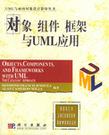对象 组件 框架与UML应用
出版时间:2003-5 出版社:科学出版社 作者:苏泽 页数:785 字数:972000
内容概要
本书介绍的是如何利用对象、框架和UML来设计和构建基于组件的软件系统并实现对系统的重用。全书共由16章组成,分为概述、对象建模、对象分析及设计、实施Catalysis应用等五个部分。不但内容详尽,而且循序渐进,非常有利于学习。 本书适合系统分析、设计人员阅读。
书籍目录
PrefacePART Ⅰ OVERVIEW Chapter 1 A Tour of Catalysis 1.1 Objects and Actions 1.2 Refinement:Objects and Actions at Different Scales 1.3 Development Layers 1.4 Business Modeling 1.5 Model Frameworks as Templates 1.6 Zooming In on the Software:System Context 1.7 Requirements Specification Models 1.8 Components 1.9 Assigning Responsibilities 1.10 Object-Oriented Design 1.11 The Development Process 1.12 Three Development Process 1.13 Three Levels of Modeling 1.14 Three Principles 1.15 SummaryPART Ⅱ MODELING WITH OBJECTS Chapter 2 Static Models:Object Attributes and Invariants 2.1 What Is a Static Model? 2.2 Object State:Objects and Attributes 2.3 Implementations of Object State 2.4 Modeling Object State:Types,Attributes,and Associations 2.5 Static Invariants 2.6 The Dictionary 2.7 Models of Business;Models of Components 2.8 Summary Chapter 3 Behavior Models:Object Types and Operations 3.1 Object Behavior:Objects and Actions 3.2 More Precise Action Specifications 3.3 Two Java Implementations of a Calendar 3.4 Type Specification of Calendar 3.5 Actions with Invariants 3.6 Interpreting an Action Specification 3.7 Subtypes and Type Extension 3.8 Factoring Action Specifications 3.9 State Charts 3.10 Outputs of Actions 3.11 Subjective Model:The Meaning of Containment 3.12 Type Specifications:Summary 3.13 Programming Language:Classes and Types Chapter 4 Interaction Models:Use Cases,Actions,and Collaborations 4.1 Designing Object Collaborations 4.2 Actions(Use Cases)Abstract Complex Interactions 4.3 Use Cases Are Joint Actions 4.4 Actions and Effects 4.5 Collaborations Actions 4.6 Collaborations 4.7 Uses of Collaborations 4.8 Collaboration Specification 4.9 Collaborations:Summary Chapter 5 Effective Documentation 5.1 What′s It All For? 5.2 Documentation Is Easy and Fun,and It Speeds Design 5.3 Reaching the Documentation Audience 5.4 The Main Documents:Specification and Implementation 5.5 Documenting Business Models 5.6 Documenting Component Specification 5.7 Documenting Component Implementations 5.8 SummaryPART Ⅲ FACTORING MODELS AND DESIGNS Chapter 6 Abstraction,Refinement,and Testing 6.1 Zooming In and Out:Why Abstract and Refine? 6.2 Documenting ?Refinement and Conformance 6.3 Spreadsheet:A Refinement Example 6.4 Spreadsheet:Model Refinement 6.5 Spreadsheet:Action Refinement 6.6 Spreadsheet:Object Refinement 6.7 Spreadsheet:Operation Refinement 6.8 Refinement of State Charts 6.9 Summary 6.10 Process Patterns for Refinement Chapter 7 Using Packages 7.1 What Is a Package? 7.2 Package Imports 7.3 How to Use Packages and Imports 7.4 Decoupling with Packages 7.5 Nested Packages 7.6 Encapsulation with Packages 7.7 Multiple Imports and Name Conflicts 7.8 Publication,Version Control,and Builds 7.9 Programming Language Packages 7.10 Summary Chapter 8 Composing Models and Specifications 8.1 Sticking Pieces Together 8.2 Joining and Subtyping 8.3 Combining Packages and Their Definitions 8.4 Action Exceptions and Composing Specs 8.5 Summary Chapter 9 Model Frameworks and Template Packages 9.1 Model Framework Overview 9.2 Model Frameworks of Types and Attributes 9.3 Collaboration Frameworks 9.4 Refining Frameworks 9.5 Composing Frameworks 9.6 Templates as Packages of Properties 9.7 Templates for Equality and Copying 9.8 Package Semantics 9.9 Down to Basics with Templates 9.10 Summary of Model Framework ConceptsPART Ⅳ IMPLEMENTATION BY ASSEMBLY Chapter 10 Components and Connectors 10.1 Overview of Component-Based Development 10.2 The Evolution Components 10.3 Building Components with Java 10.4 Components with COM+ 10.5 Components with CORBA 10.6 Component Kit:Pluggable Components Library 10.7 Component Architecture 10.8 Defining Cat One-A Component Architecture 10.9 Specifying Cat One Components 10.10 Connecting Cat One Components 10.11 Heterogeneous Components 10.12 Summary Chapter 11 Reuse and Pluggable Design Frameworks in Code 11.1 Reuse and the Development Process 11.2 Generic Components and Plug-Points 11.3 The Frameworks Approach to Code Reuse 11.4 Framework:Specs to Code 11.5 Basic Plug Technology 11.6 Summary Chapter 12 Architecture 12.1 What Is Architecture? 12.2 Why Architect? 12.3 Architecture Evolution with Scenarios 12.4 Architecture Builds on Defined Elements 12.5 Architecture Uses Consistent Patterns 12.6 Application versus Technical Architecture 12.7 Typical Four-Tier Business Architecture 12.8 User Interfaces 12.9 Objects and Databases 12.10 SummaryPART Ⅴ HOW TO APPLY CATALYSIS Chapter 13 Process Overview 13.1 Model,Design,Implement,and Test-Recursively 13.2 General Notes on the Process 13.3 Typical Project Evolution 13.4 Typical Package Structure 13.5 Main Process Patterns Chapter 14 How to Build a Business Model 14.1 Business Modeling Process Patterns 14.2 Modeling Patterns 14.3 Video Case Study:Abstract Business Model 14.4 Video Business:Use Case Refinement Chapter 15 How to Specify a Component 15.1 Patterns for Specifying Components 15.2 Video Case Study:System Specifications 15.3 System Context Diagram 15.4 System Specification 15.5 Using Model Frameworks Chapter 16 How to Implement a Components 16.1 Designing to Meet a Specifications 16.2 Detailed Design Patterns 16.3 Video Case Study:Components-Based DesignAppendix A Object Constraint LanguageAppendix B UML PerspectiveAppendix C Catalysis Support Tools,Services,and ExperiencesNotesGlossaryIndex
图书封面
评论、评分、阅读与下载
